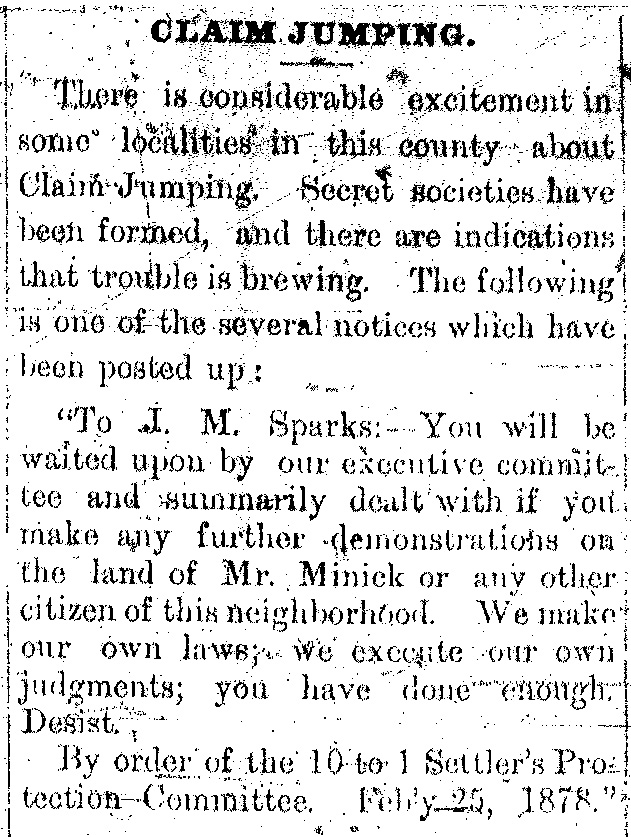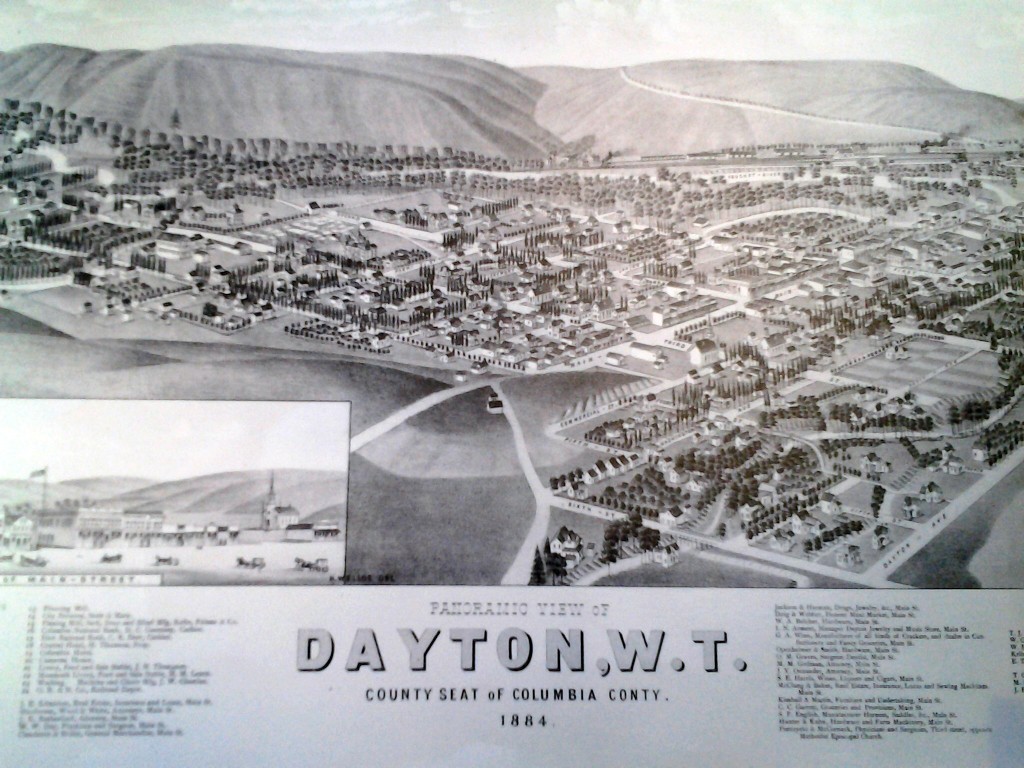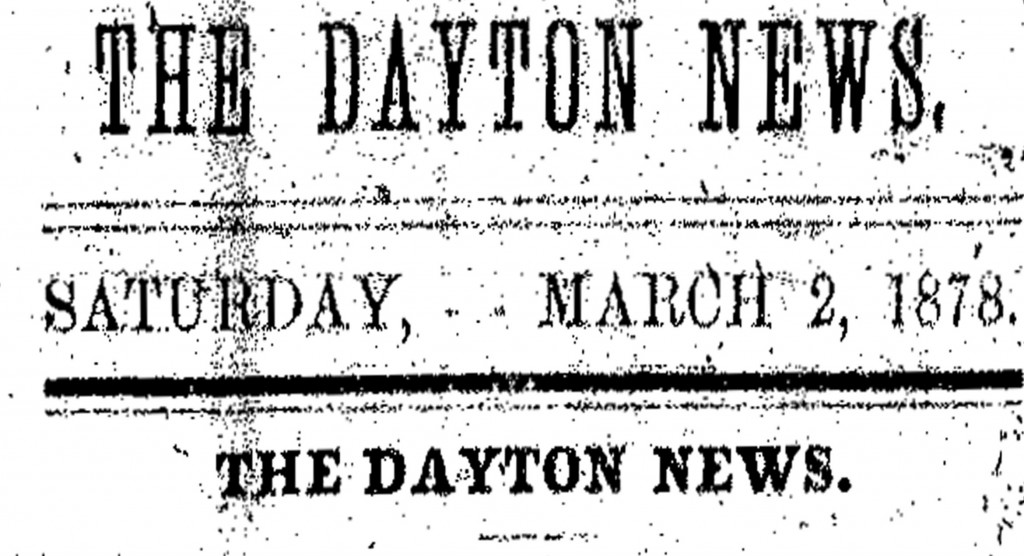Secret Societies and Vigilantes in Dayton
From the desk of Steve Willis, Central Library Services Program Manager of the Washington State Library:
If there is any doubt that Washington Territory was part of the Old West, the following information regarding vigilante groups in Columbia County in the 1870s-1880s should put that to rest.
This week’s reel grabbed at random turns out to be from Dayton, in Columbia County, in 1878. But before we dive in, let’s let Robert E. Ficken set the scene from his excellent work, Washington Territory (2002):
“Founded in 1872 on the upper Touchet, sixteen miles south of the Snake River, Dayton was the leading urban byproduct of expanding wheat production. City-like amenities included flour and woolen mills, a brick-walled store, a flourishing hotel, two churches and a ‘well regulated brass band.’ Dayton was nonetheless an uncivilized place of materialist ambition enveloped in dust from never-ending winds. The school closed when residents refused to pay taxes. ‘Young hoodlums,’ the loutish offspring of prosperous farmers, loitered about and ‘soiled doves’ occupied their own well-patronized quarter, separated from respectable folk by an appropriately festering ditch.”
(As an aside, Mr. Ficken was our very first speaker when we started our WSL lecture series in 2002)
The following Dayton News article appeared on the editorial page, March 2, 1878:
CLAIM JUMPING
“There is considerable excitement in some localities in this county about Claim Jumping. Secret societies have been
formed, and there are indications that trouble is brewing. The following is one of the several notices which have been posted up:”
“‘To J.M. Sparks: You will be waited upon by our executive committee and summarily dealt with if you make any further demonstrations on the land of Mr. Minick or any other citizen in this neighborhood. We make our own laws; we execute our own judgments; you have done enough. Desist.'”
“‘By order of the 10 to 1 Settler’s Protection Committee. Feb’y 25, 1878.'”
“This looks like business. We have also private advices of like tenor. Secret Societies have been formed, and they are acting in concert. It is not our design to side with either party except in so far as they are right. We have always deprecated mob violence; we never knew any good to come of it except perhaps in the early history of California and Montana. The land laws are full, and plain, and easilyunderstood. Let every body go in streit accordance with the laws and there will be no trouble. When a man claims land let him be sure he is right– that all the steps he takes strictly accord with the land laws; then, should any one ‘jump’ his claim, he can have his wrongs righted legally. We agree with the last Walla Walla Union, when it says:”
“‘Claim jumping is very reprehensible; no person has a right to take from his neighbor his labor or other property without giving him an equivalent. In this country where there are so many acres of good land still vacant, and very desirably located, there is but little excuse for this wholesale land grabbing; where too, the country is large enough and wide enough for every person to take himself a farm.'”
Unfortunately, The Dayton News ceased to exist in less than a month after this piece was published.
What happened next has been covered by the work Columbia County, Washington : Genealogy and History:
“Considerable ‘land jumping’ was indulged in by various parties in the vicinity of Dayton, in the spring of 1878, and the farmers united to discourage such proceedings. A committee waited upon J.M. Sparks and notified him to vacate a ranch he had ‘jumped,’ but instead of heeding their warning, he defied and abused them so vigorously that they were glad to retire from his presence. On the afternoon of the twenty-seventh of March, Sparks was in Dayton, when he was approached by the son of one of the committeemen, who knocked him off the sidewalk. From the appearance of a number of men standing around, Sparks was satisfied they were ‘after’ him, and he drew his revolver and fired a harmless shot at his assailant’s legs. Sparks was then attacked by a brother of his assailant, whom he wounded by shooting him in the leg. Several others then advanced to the attack, and Sparks ran into Shrum’s stable, then behind an adjoining harness shop, from which place he exchanged shots with a man who was watching for him in the street. Sparks received a bullet in the cheek and another in the neck, and it was with difficulty that the officers and people of Dayton prevented the angry farmers from lynching the wounded man. When Sparks re-covered he left the county, and the Settlers’ Protection Committee gave public notice that land-jumping would not be tolerated in the future. The man wounded in the leg suffered the amputation of that limb.”
 Sparks was not lynched. That activity would be saved for another person at a later date in Dayton, in August, 1883, when a mob worried that convicted murderer James McPherson would somehow escape the legal noose via bribery decided to take matters into their own hands. From Lyman’s History of Old Walla Walla County (1918) which is available from WSL in digital form as well as a hard copy:
Sparks was not lynched. That activity would be saved for another person at a later date in Dayton, in August, 1883, when a mob worried that convicted murderer James McPherson would somehow escape the legal noose via bribery decided to take matters into their own hands. From Lyman’s History of Old Walla Walla County (1918) which is available from WSL in digital form as well as a hard copy:
“Great efforts were made for a reprieve. Judge Caton secured a stay of proceeding for McPherson. The news of this excited great feeling throughout the community where the conviction was strong that [McPherson was] guilty in the revolting crime. During the afternoon of August 4th little knots of men, mainly farmers, might have been seen talking earnestly, breaking up their groups whenever any one not in their confidence approached. It was evident that something portentous was at hand.”
“The old vigilante organization had representatives in the community. With that element was a nucleus, a committee called the committee of the hundred and one, was speedily organized and about midnight a strong body of men gathered in the courthouse square. They speedily stormed the jail, in spite of the firing of the guard, overpowered him, broke into the cell where McPherson was chained, took him out and hanged him.”
For a broader and more balanced view of Dayton’s history, be sure to visit the Columbia County Heritage website.
You can follow any responses to this entry through the RSS 2.0 feed. Both comments and pings are currently closed.







